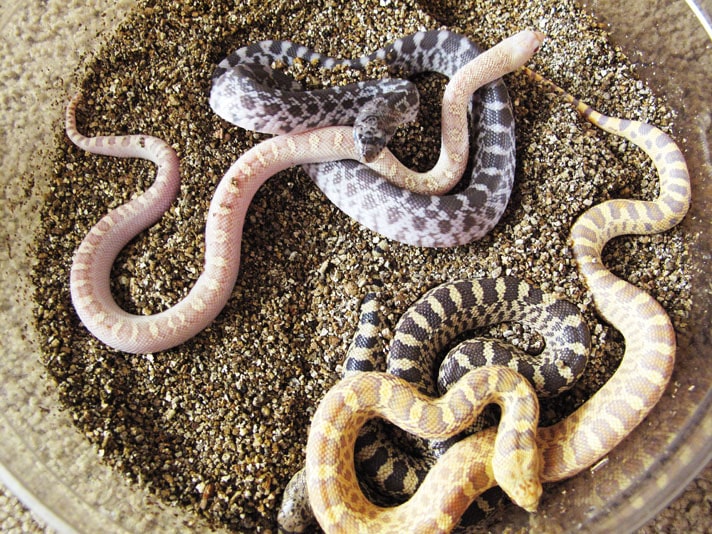With more captive-bred color mutations, the gopher snake enjoys newfound popularity.
I’ve noticed an interesting trend while working with my local herpetological society: The crowds will be drawn to our booth by the giant exotics initially, but after the photos are finished, it’s always a much more humble critter they talk about—our gopher snake. Whether they love reptiles or loathe them, it seems as though everyone has experience catching gopher snakes as children, everyone has stories concerning what identifying characteristics the Boy Scouts taught them to look for, and, of course, everyone has a fish tale about the monster one they swear was over 12 feet long.
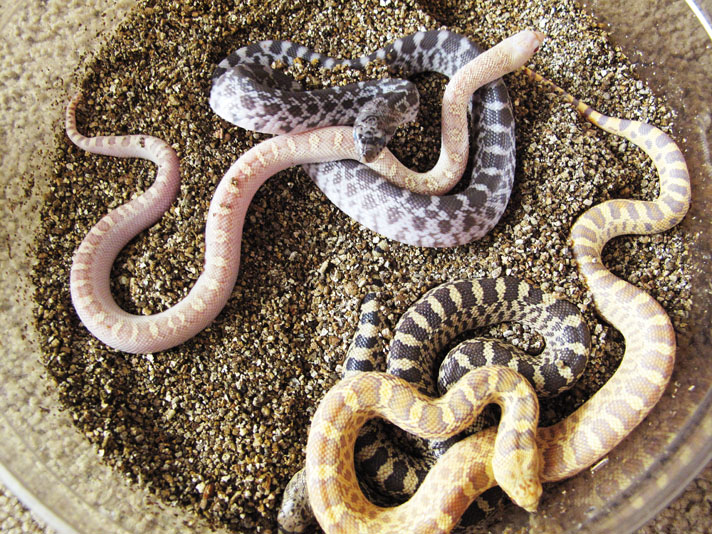
autumn re
Several of the author’s hatchlings of various mutations.
So even though a gopher snake may not be the reptile people line up to take their picture with, this seemingly unremarkable creature never fails to connect with the general public, and, in many ways, its wide-spread reputation grants us the most education opportunities. This gift of theirs is just one of many reasons why the everyday gopher snake remains one of my all-time favorite animals.
Get to Know Your Gopher Snakes
Gopher snakes (Pituophis catenifer ssp.) are nonvenomous, ground-dwelling constrictors. Although all are similar in appearance and care, their average size differs among subspecies. The bull snake (P. c. sayi) is the largest; it regularly reaches 6 feet in length, and has even been recorded over 8 feet, making it one of North America’s biggest snakes. Don’t let that scare you off from gophers as a whole, though, because the majority max out at just over 4 feet in length. Females typically weigh more, but all healthy individuals should be heavy-bodied and bulkier than a standard colubrid.
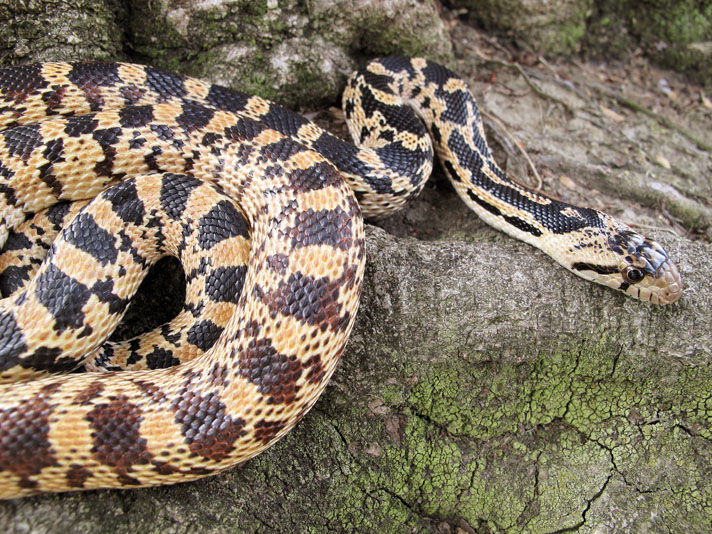
autumn re
A young Great Basin gopher snake.
The gopher snakes’ wide range lends to a lot of variation in their appearance, but in general, they all have creamy underbellies and their background color is beige to yellow with brown to black blotches on top that form a chain-like pattern. The exact amount, shape and color of these saddles varies among subspecies. Some hobbyists will work solely with animals from a certain locality in order to keep the natural traits pure; others focus more on exotic colors and patterns, such as albino, axanthic, hypomelanistic, striped,and patternless morphs. The forms are virtually endless thanks to selective breeding in captivity!
“Normal” gophers can still be found along the Pacific coast throughout North America, from southwestern Canada, down through the western United States and into Mexico. Because gopher snakes are generalists, they thrive in a variety of habitats, from sandy deserts to coniferous forests. They seem to prefer mild, dry habitats overall, and often live right outside human settlements, likely drawn to our rodent tagalongs.
Although primarily diurnal, weather influences gopher snake behavior. On very cold days they will need to spend more time warming up in the morning to store energy, and on dangerously hot days they will need to stay out of the sun until temperatures drop at night. These snakes forage for mates and food when active, assisted by keeled scales that help provide traction when climbing and texture to better grip their prey.
Want To Learn More?
Their favorite prey, as their common name suggests, is gophers and similar rodents. However, gopher snakes possess a voracious appetite and won’t hesitate to gobble down any birds, lizards, or eggs they might find. Unlucky gopher snakes fall prey themselves to hawks, coyotes, kingsnakes and high-strung humans. Barring this kind of intervention, exceptional individuals have been known to live for more than 30 years, though 15 is much more likely.
Due to their resiliency and ease of breeding, gopher snake prices in the pet industry remain relatively low, and they can be readily purchased year-round from reptile stores, at expos, or through online classifieds. I highly recommend these sources over attempting to collect a wild snake yourself, because their animals are already adjusted to captive living and should have a documented health history. No matter which route you chose, be aware that some states have rules against owning native species without a permit, and because regulations are always changing, I suggest you double-check your local laws before obtaining a gopher snake as a pet.
The Best Gopher Snake Enclosure
There are several caging options for pet gopher snakes. A screen-topped, glass tank is great for viewing your pet. Cover up one or more sides with a decorative background to increase its visual appeal and help shy snakes feel more secure. You can’t stack them without special equipment, so tanks are best suited for keepers with smaller collections. If that’s you, then you can start hatchling gopher snakes off in a 5-gallon tank before ultimately upgrading an adult to at least a 30-gallon enclosure.
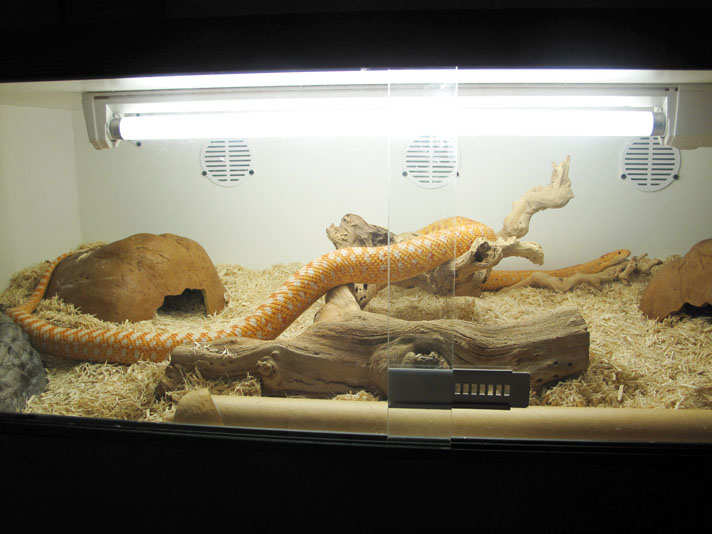
autumn re
Because gopher snakes need floor space more than height, rack system caging also works well for them, and is wonderfully efficient for the keeper with multiple animals.
Because gopher snakes need floor space more than height, rack system caging also works well for them, and is wonderfully efficient for the keeper with multiple animals. Rack enclosures don’t make good displays, however, and that’s a shame because observing our animals is one of the more enjoyable aspects of herpetoculture. I suggest an enclosure in a rack system always be at least half the snake’s body length. In the case of tubs, this usually means starting them off in 6 quarts, eventually upgrading them to 28 quarts, and, finally, placing a full-grown adult in a tub that’s at least 41 quarts. Different brands will have different dimensions; just keep in mind that you need to be able to fit a properly sized hide and water dish in the enclosure along with the snake, while also supporting a thermal gradient (more on this later). You don’t want it too cramped.
Solid-walled enclosures with front-opening doors are a happy medium between the previous two options, being stackable while also allowing you to clearly see your snake. I personally favor these types of cages for larger animals, and I use 4 by 2-foot versions for my adult gopher snakes. Fortunately, there are several brands on the market geared toward reptiles, or if you prefer, you can also construct one yourself, being sure to use non-porous, pet-safe materials.
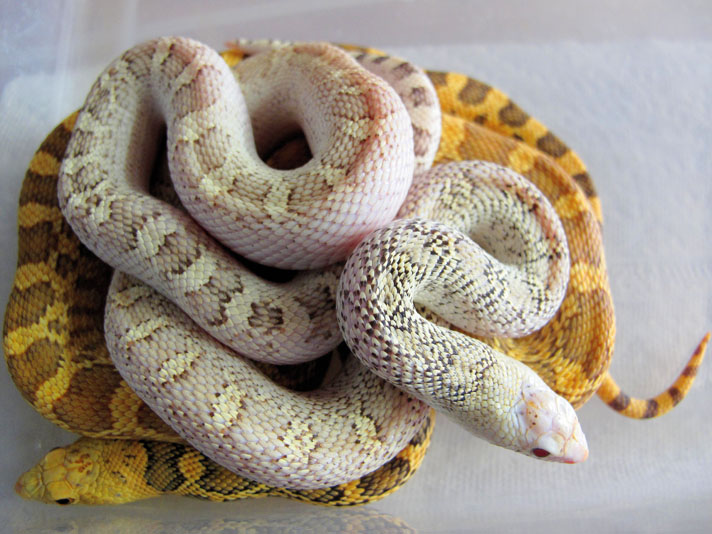
autumn re
Bull snake morphs.
No matter what type of caging you decide on, it’s vital that it be able to close completely and securely, as gopher snakes are skilled escape artists. I suggest a locking enclosure, too.
Your gopher snake won’t require any special lighting to stay healthy, but the amount of light it perceives may affect its behavior. If the snake’s enclosure is near a window, as the days get shorter, your snake may stop eating in anticipation for the upcoming winter. This kind of seasonal cycling can be beneficial if you’re hoping to breed snakes in the spring, but you can also try to prevent it by providing at least 12 hours of artificial light every day. Using an electric timer will make this easier.
Gopher snakes are cold-blooded animals that need to physically move themselves to hotter or colder areas in order to regulate their body temperature. Therefore, you’ll need to provide a thermal gradient in their enclosure so they can choose which temperature best suits their current needs. This is easily accomplished by placing a heat source—a heat bulb, heat emitter, etc.—at one end of the cage, and allowing the other end to remain at room temperature.
The ideal temperature range for your pet would be in the mid 70s to the mid 80s Fahrenheit. I’ve noticed that my gophers from coastal origins seem content with a hot side of just 82 degrees, whereas those from the desert prefer it around 87. That said, all gopher snakes are tolerant of a wide range of temperatures, and because their needs are always changing, I suggest you monitor your snake’s behavior closely. A snake that is spending a lot of time in its water dish or constantly trying to escape may be too hot. And one that never moves from the heat may be too cold. Use a thermometer or temp gun to confirm temperature, and adjust as needed. Adjusting temperature is easy if you connect your heat source to a controllable thermostat; I also recommend doing so to prevent burns.
Place at least one hiding place—a cave, hide box, etc.—on each side of the enclosure, in both the warmer end and the cooler one. Fresh water should also be available at all times in a dish large enough for your snake to soak in. I recommend using heavy or corner-shaped water dishes so they aren’t constantly getting knocked over by the snake.
Other cage accessories may include tubes and branches, which provide mental stimulation for your snake and assists in shedding. Periodically moving cage furniture around or adding new things for snakes to explore may interest them, just be sure to not provide anything that’s potentially harmful or that a snake may get stuck in. The décor can be as simple or elaborate as you choose, but in my experience, the more decorative items are harder to clean and more likely to be flattened by a curious snake.
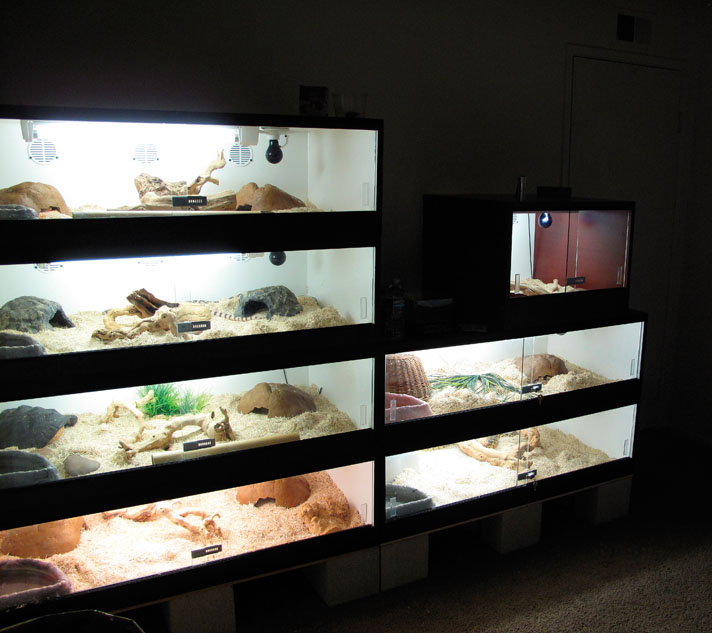
autumn re
A critter condo is ideal for those with large collections.
In a similar vein, you may choose to use either a loose particle substrate or simple paper liners as bedding. Paper liners will have to be completely changed out whenever your snake makes a mess, whereas particle bedding allows for spot cleaning. Because most of my gophers enjoy burrowing, I give mine a thick layer of wood shavings to dig around in. Aspen is my go-to, and I steer clear of odorous woods such as cedar or pine because they may be toxic to reptiles. Whatever bedding you decide to go with, make sure it stays dry, as habitually wet substrate can lead to mold and blisters on your snake.
Basic Care For Gopher Snakes
Gopher snakes are low-maintenance pets; your single, daily chore will be ensuring that the enclosure is in good order. It should always be clean, at the correct temperature, and stocked with fresh water. The only time you should ever need to adjust the humidity is after you notice that your snake is beginning a shed cycle, signs of which are dull scales, cloudy eyes, and reclusive behavior. At this time, place a high-humidity shed box full of damp moss or moistened paper towels in the cage. Spray inside it as needed to keep the contents moist, and after about a week, your snake should slough off its old skin in one piece, complete with eye spectacles and tail tip.
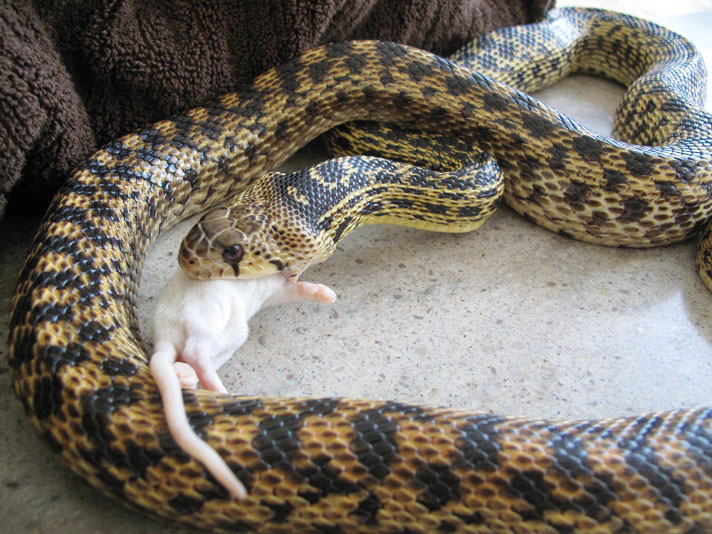
autumn re
Food only needs to be offered to gopher snakes once weekly.
Should a gopher snake feel threatened, it can put on an impressively loud show, rattling its tail against the ground, flattening its head, and generating a distinct hiss upon exhalation by vibrating a flap in front of the glottis. Paired with their chain like pattern, this bluff often leads the harmless gopher to be mistaken for a venomous rattlesnake, and though the gutsy performance may be effective in scaring away other animals, humans respond with hostility more often than not.
Despite the aforementioned displays and strong feeding response, gopher snakes are easily handled. A snake locked in feeding mode can usually be snapped out of it by using an object, such as a snake hook or tongs, to firmly nudge its head. Likewise, the majority of posturing snakes are merely being cage-defensive, and they will either drop the act completely when picked up or else will change tactics to musking and fleeing.
Regular handling over time will typically result in a calmer snake, especially with hatchlings that tend to be more flighty as a whole, and sometimes nippy. Just be confident with your grasp and support their weight. It’s also best to leave snakes alone while they’re in shed or right after they’ve eaten a meal.
Food only needs to be offered to gopher snakes once weekly. They are almost always up for another meal, so be careful not to overfeed them. Prey should be as big as or slightly larger than the widest part of the snake’s body. Because live rodents may bite and injure a snake, I strongly recommend feeding frozen/thawed or pre-killed prey. Generally, this is a non-issue, because gophers will eat almost anything and are very eager feeders. You may even get sized up as a meal upon first opening the cage, and this eagerness is why I recommend you use tongs when offering captive gopher snakes food.
Gopher Snake Reproduction
Breeding gopher snakes can be very rewarding, both in a monetary and emotional sense, but it involves a risk to your animals and much more work on your part than simply owning them. We sometimes take losses in this hobby, again in both a monetary and emotional sense, so the first thing to do is be absolutely sure that you’re ready to handle the responsibility of possible vet bills and all those mouths to feed.
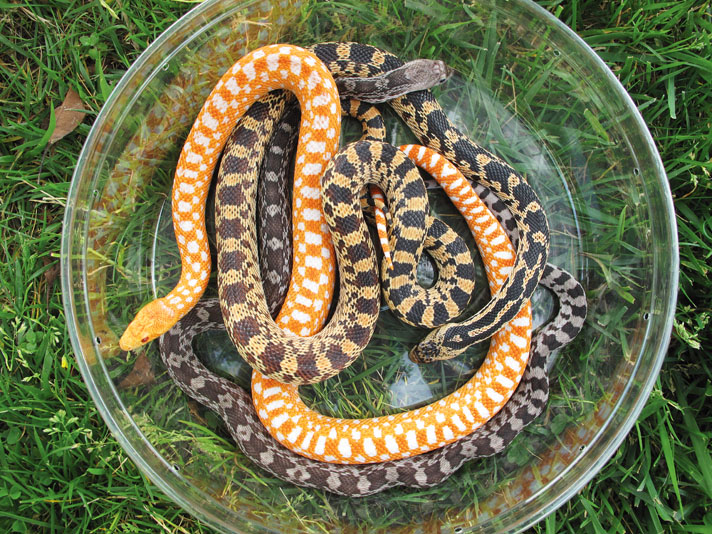
autumn re
A variety of gopher snake morphs.
Next, you’ll want to set yourself up for success by starting with good stock. Both for the safety of your pets and the overall continuation of the species, I strongly recommend against breeding any animals expressing flaws such as spinal kinks or neurological disorders.
Lastly, ensure that your pair is of healthy weight, as it’s not uncommon for animals to go off food while breeding. Your female, especially, should be robust and at least 3 years old.
To begin, put your pair through a cooling period in the late fall. This cooling is known as “brumation,” and during it, your snakes’ metabolism is going to slow significantly, so you’ll want to make sure they’ve finished processing any meals in their systems before cooling them down. After you’ve gone a few weeks without feeding them, gradually cut back on their lighting and heat until the enclosure temperature drops to 55 degrees.
Living in Southern California, I’ve occasionally found low temps impossible to reach without artificial means. Fortunately, such extremes don’t seem to be required every time for successful reproduction of this species, and simply turning off any light and heat that you are providing, along with the winter fasting period, suffices. I personally believe that these guys can already sense the seasons changing around them, and that we as keepers simply reinforce that by turning light and heat off. I’ve always had success, even when not getting the temperature down to 55 degrees, and even with gophers originating from cold weather areas, so don’t panic if you’re in the same boat as me.
After doing nothing but monitoring the snakes—no feeding—and providing fresh water all winter, come spring, start slowly increasing the lighting and heat over the course of several days. Once you’ve raised the temperature back to the normal range, resume your snakes’ regular care schedule, being sure to feed them heavily in preparation for what’s ahead.
Introduce the male to the female after their first post-brumation shed. I like to transfer the male to the female’s enclosure because it should be full of her pheromones at this point, and also because I want her as cooperative as possible (males never seem to mind the change in scenery as much).
Gopher snakes can be very aggressive breeders, so don’t be alarmed if you see your male biting your female’s neck to subdue her. You can separate them every few days to give them a break and offer food.
Your female will need to devote a lot of energy into developing eggs, so once she’s gravid, ensure that she’s kept warm and well fed. She will be ready to lay about six to eight weeks after copulation, and should shed the week prior to laying. A safe place to nest is required at this time; a large tub full of damp sphagnum moss works well. Keep a careful eye on the female, and if she’s not spending most of her time in the nestbox by this point, she may be thinking that her regular hide box is more suitable. Also, replace her usual water dish with a smaller one after her pre-lay shed; you don’t eggs laid in the water dish.
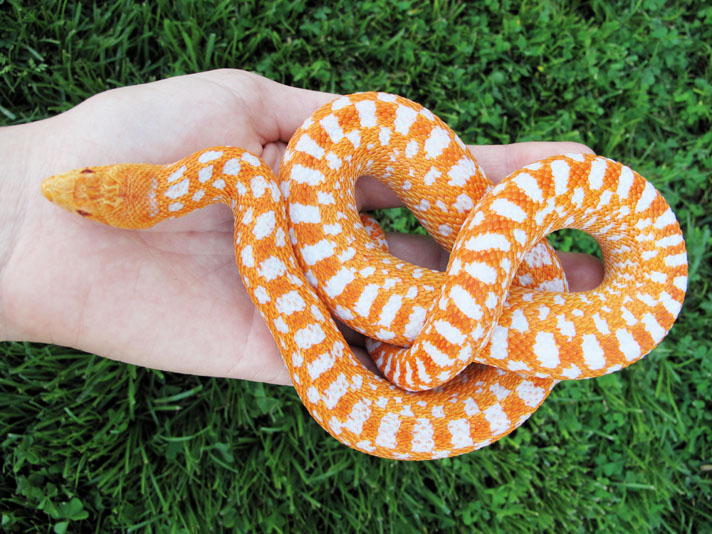
autumn re
This is an albino Pacific gopher snake.
Once provided with a satisfactory nesting area, the female will lay up to 24 eggs, normally during the night. Fertile eggs will be white, large, and leathery; infertile “slugs” tend to be yellow, smaller, and hard. Fertile eggs will also adhere together if allowed to set a while; I suggest incubating the entire clump at once, if possible. If you must separate the eggs, do so carefully, using dental floss in a sawing motion, to avoid tearing them, and try to keep them right-side-up during the process.
Incubate at a temp between 78 and 84 degrees (aim for 82). The popular method of mixing water and vermiculite equally by weight works well as an incubation medium, but any mixture will do the trick provided that the humidity remains steady. I like to set up my incubator a few days beforehand, so I can observe how condensation forms inside the egg boxes and make any adjustments, if necessary. I’ve found that correcting dryness in dimpled eggs is as easy as adding a bit more water, but too much moisture is often irreversible, so err on the side of caution when wetting your medium. After about 55 to 75 days, the day arrives when you’ll start to see little noses pipping the eggs. Resist the urge to cut your eggs early; allow the hatchlings to slither out on their own before removing them from the incubator. Your bitsy babies will already have remarkable spirit, so don’t be surprised if you see them rattling their tails and hissing straight from the egg!
Set baby gopher snakes up using the same parameters used with their parents, but with plenty of places to hide and a damp paper towel to assist with their first shed. They should finish shedding within a week of hatching, and you can offer them their first meal afterward. Hatchling gopher snakes usually accept frozen/thawed prey right away, and because they’re likely to be over 12 inches in length already, there’s no need to hassle with pinky parts or mice tails. Offer them whole prey once a week and enjoy watching them grow into what I consider one of nature’s most captivating snakes!
Autumn Ré is most fascinated by the wildlife she can find in her own backyard. She works primarily with native species and volunteers in several outreach programs, educating the public on the importance of preserving reptiles within their local ecosystems.

